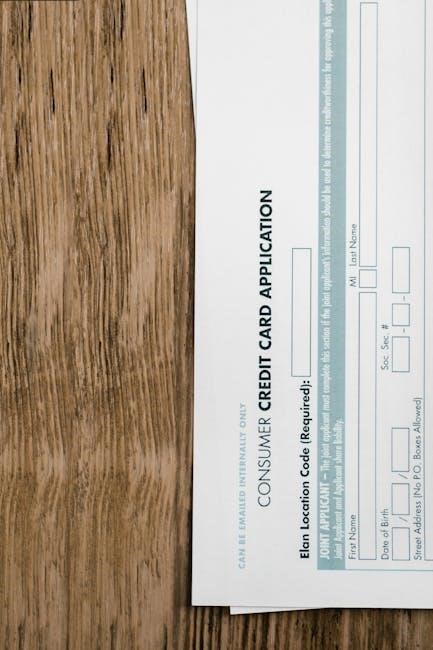Assistive Devices Program (ADP) Application Form: A Comprehensive Guide
The Assistive Devices Program (ADP) application form is essential for Ontario residents seeking financial assistance for customized equipment. Completing it accurately, often with assistance from healthcare professionals, ensures proper evaluation and potential approval for devices that improve quality of life. The completed form is mailed to the Assistive Devices Program.
Overview of the Assistive Devices Program (ADP)
The Assistive Devices Program (ADP) in Ontario provides financial support to individuals with long-term physical disabilities, helping them access customized equipment and specialized supplies. The program aims to reduce the financial burden associated with assistive devices, promoting independence and enhancing the overall well-being of eligible residents. ADP covers a portion of the costs for various devices, including wheelchairs, hearing aids, and respiratory equipment.

To participate, applicants must complete an application form, often with the assistance of healthcare professionals. The program emphasizes the importance of proper assessment and authorization by qualified professionals, such as occupational therapists or physiotherapists, to ensure the equipment meets individual needs. The application process involves submitting the completed form with required signatures to the ADP for review.
The ADP is transitioning to eSubmissions for all device categories to streamline the application process. This move towards electronic submissions aims to increase efficiency and reduce processing times. The program’s eligibility criteria, application procedures, and covered devices are detailed in the application form and related program materials. Understanding these details is crucial for a successful application. The program also provides information on vendor selection and potential funding from other sources.
Eligibility Criteria for ADP Funding

To be eligible for funding from the Assistive Devices Program (ADP) in Ontario, applicants must meet specific criteria. Firstly, applicants must be residents of Ontario and possess a valid Ontario health card. This ensures that only Ontario residents can access the program’s benefits. Secondly, individuals must have a long-term physical disability requiring the equipment or supplies for which they are applying. This requirement emphasizes the program’s focus on supporting those with enduring needs.
The ADP also stipulates that the requested equipment must be essential for the applicant’s daily living and rehabilitation. The specific disability requirements vary depending on the device category, as outlined in the application form. An ADP authorizer, typically a healthcare professional, assesses the applicant’s condition and determines whether the requested equipment is appropriate.
Furthermore, applicants must demonstrate that they meet the minimum disability requirements for the specific devices they seek. These requirements are detailed in the application form and defined by the ADP. The ADP application form must be completed with the help of the occupational therapist or physiotherapist. Meeting all eligibility criteria is crucial for approval.
Types of Assistive Devices Covered by ADP
The Assistive Devices Program (ADP) offers financial assistance for a wide range of assistive devices and specialized supplies, catering to diverse needs. Mobility devices, such as wheelchairs, positioning devices, and ambulation aids, are commonly covered, enabling individuals with mobility impairments to move more freely and independently. Respiratory equipment and supplies, critical for individuals with respiratory conditions, also fall under the ADP’s coverage.
Hearing aids are another significant category, assisting those with hearing loss to improve their auditory capabilities. The program extends to specialized supplies used with ostomies, ensuring individuals with ostomies have access to essential resources. Furthermore, the ADP supports customized equipment tailored to individual needs, promoting greater functionality and comfort.
It’s important to note that eligibility criteria apply to each device category, and applicants must complete an authorization form before making equipment purchases. A healthcare professional must authorize the devices, and they must be purchased from an ADP-authorized vendor. This comprehensive coverage aims to enhance the quality of life for individuals with long-term physical disabilities by providing access to necessary assistive devices and supplies.
The ADP Application Form: Download and Access
Accessing the Assistive Devices Program (ADP) application form is a crucial first step in seeking financial assistance for assistive devices in Ontario. The application forms are readily available online, typically in PDF format, making them easily downloadable and accessible to applicants. These forms are often categorized alphabetically according to device name, simplifying the process of locating the appropriate form for a specific need.
Many websites provide direct links to download the application form, ensuring convenient access. Some platforms also offer options to view the form online before downloading, allowing applicants to familiarize themselves with the required information. It’s essential to download the correct application form corresponding to the specific assistive device being sought, as eligibility criteria and required information may vary.
Applicants can also obtain the application form from healthcare professionals, such as occupational therapists or physiotherapists, who are often involved in the application process. Additionally, ADP-authorized vendors may provide the application form to individuals seeking assistive devices through their services. Having easy access to the ADP application form streamlines the application process, enabling eligible individuals to apply for funding assistance promptly.
Filling Out the ADP Application Form: Step-by-Step
Completing the Assistive Devices Program (ADP) application form accurately is vital for securing funding. Begin by carefully reading the entire form and its instructions. Gather all necessary information, including personal details, medical history, and specifics about the required assistive device.
Seek assistance from an occupational therapist or physiotherapist, who can provide guidance on completing the form correctly and ensure all necessary details are included. Provide accurate and honest responses to all questions, ensuring consistency throughout the application. Include relevant supporting documents, such as medical assessments or reports, to strengthen your application.
If applicable, work with an ADP-registered vendor to obtain information about the device’s specifications and cost. Ensure that all sections of the form are completed, including those pertaining to the device’s details, the applicant’s needs, and the healthcare professional’s assessment. Double-check all information for accuracy and completeness before submitting the form.
Remember to obtain all required signatures, including those of the applicant, physician, and vendor. By following these step-by-step instructions and seeking assistance when needed, applicants can increase their chances of a successful ADP application.
Required Signatures on the Application Form
The Assistive Devices Program (ADP) application form mandates specific signatures to validate its authenticity and ensure the application’s completeness. The applicant, or their authorized agent, must sign the form to confirm the accuracy of the provided information and their consent to the application. In cases where an applicant is unable to sign, a legally authorized representative can sign on their behalf.
A qualified physician, familiar with the applicant’s medical condition and need for the assistive device, must also sign the application. The physician’s signature verifies the medical necessity of the requested device and confirms that it aligns with the applicant’s health requirements. Furthermore, an authorized vendor, registered with the ADP, is required to sign the application.
The vendor’s signature confirms their agreement to provide the specified device at the quoted price and their adherence to ADP guidelines. It also verifies that the vendor has assessed the applicant’s needs and determined that the device is appropriate. Without these required signatures, the ADP application form is considered incomplete and will not be processed.
Therefore, it’s crucial to ensure that all necessary parties sign the form before submission to avoid delays or rejection; Obtaining these signatures demonstrates the collaborative effort between the applicant, healthcare provider, and vendor in addressing the applicant’s assistive device needs.
Submitting the ADP Application Form: Methods and Address
Once the Assistive Devices Program (ADP) application form is fully completed and signed by all required parties, including the applicant, physician, and vendor, it must be submitted to the ADP for processing. Currently, the primary method for submitting the application is via mail. Ensure all sections are filled accurately and completely before mailing to prevent delays.
The mailing address for the ADP is Assistive Devices Program, 5700 Yonge Street, 7th Floor, Toronto ON M2M 4K5. It is crucial to verify the accuracy of this address before sending the application to ensure it reaches the correct destination. While the ADP is transitioning towards electronic submissions (eSubmissions), it’s important to confirm the availability of this option for specific device categories.
Check the ADP website or contact them directly to inquire about eSubmission availability. When mailing the application, consider using registered mail or another trackable method to confirm receipt by the ADP. Keep a copy of the completed application form and any supporting documents for your records. Attachments, such as repair quotes for replacement of ADP-funded equipment, should be included if required.
However, note that other unsolicited attachments may not be considered. Submitting the application promptly after obtaining all signatures will help expedite the review process. Regularly check the ADP website for updates on submission methods and processing times.

The Role of Healthcare Professionals in the Application Process
Healthcare professionals, such as occupational therapists and physiotherapists, play a vital role in the Assistive Devices Program (ADP) application process. They assist applicants in completing the form accurately, ensuring all relevant medical information is included. These professionals assess the applicant’s needs and determine the most appropriate assistive device to address their specific challenges.
The ADP authorizer, often a qualified therapist, evaluates the applicant for the necessary equipment, like wheelchairs, and helps complete the application form. They guide applicants through the process, providing expertise and support. Their involvement ensures the chosen device aligns with the applicant’s functional abilities and medical condition.
Healthcare providers help gather and submit necessary documentation, including medical assessments and prescriptions. Their signatures on the application form are often required, validating the medical necessity of the requested device. They also work with ADP-registered vendors to ensure the selected device meets the applicant’s needs and ADP standards.
Additionally, healthcare professionals can offer guidance on other potential funding sources and support services. They advocate for their patients, ensuring they receive the assistive devices required to improve their independence and quality of life. Collaboration with healthcare providers streamlines the ADP application, increasing the likelihood of a successful outcome.

eSubmissions for ADP: Transition to Electronic Format
The Assistive Devices Program (ADP) is transitioning to eSubmissions to streamline the application process and enhance efficiency. This move towards an electronic format aims to simplify the submission of applications and supporting documents. The eSubmission system offers several advantages, including faster processing times and reduced paperwork.
Applicants and healthcare professionals can benefit from the convenience of submitting applications online, eliminating the need for physical mail. The electronic format allows for easier tracking of application status and reduces the risk of lost documents. This transition improves communication between applicants, healthcare providers, and the ADP.
eSubmissions also support the ADP’s commitment to environmental sustainability by reducing paper consumption. The electronic system ensures data security and confidentiality, protecting sensitive information shared during the application process. This modernization allows ADP staff to focus on application review and approval, improving overall program effectiveness.
The transition to eSubmissions involves clear guidelines and training resources to assist applicants and healthcare professionals in navigating the new system. The ADP aims to make the transition smooth and accessible, ensuring all users can benefit from the electronic format. The implementation of eSubmissions represents a significant step towards a more efficient and user-friendly ADP.
